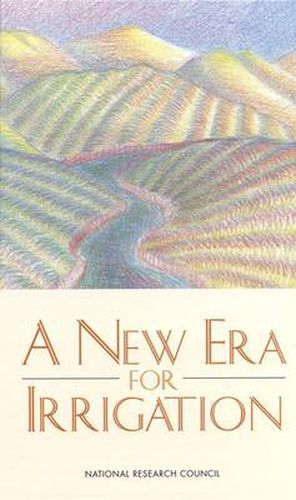Readings Newsletter
Become a Readings Member to make your shopping experience even easier.
Sign in or sign up for free!
You’re not far away from qualifying for FREE standard shipping within Australia
You’ve qualified for FREE standard shipping within Australia
The cart is loading…






Irrigated agriculture has played a critical role in the economic and social development of the United States - but it is also at the root of increasing controversy. How can irrigation best make the transition into an era of increasing water scarcity? In A New Era for Irrigation , experts draw important conclusions about whether irrigation can continue to be the nation’s most significant water user, what role the federal government should play, and what the irrigation industry must do to adapt to the conditions of the future. A New Era for Irrigation provides data, examples, and insightful commentary on issues such as: growing competition for water resources; developments in technology and science; the role of federal subsidies for crops and water; uncertainties related to American Indian water rights issues; concern about environmental problems, and more. The committee identifies broad forces of change and reports on how public and private institutions, scientists and technology experts, and individual irrigators have responded. The report includes detailed case studies from the Great Plains, the Pacific Northwest, California, and Florida, in both the agricultural and turfgrass sectors. The cultural transformation brought about by irrigation may be as profound as the transformation of the landscape. The committee examines major facets of this cultural perspective and explores its place in the future. A New Era for Irrigation explains how irrigation emerged in the nineteenth century, how it met the nation’s goals in the twentieth century, and what role it might play in the twenty-first century. It will be important to growers, policymakers, regulators, environmentalists, water and soil scientists, water rights claimants, and interested individuals.
$9.00 standard shipping within Australia
FREE standard shipping within Australia for orders over $100.00
Express & International shipping calculated at checkout
Irrigated agriculture has played a critical role in the economic and social development of the United States - but it is also at the root of increasing controversy. How can irrigation best make the transition into an era of increasing water scarcity? In A New Era for Irrigation , experts draw important conclusions about whether irrigation can continue to be the nation’s most significant water user, what role the federal government should play, and what the irrigation industry must do to adapt to the conditions of the future. A New Era for Irrigation provides data, examples, and insightful commentary on issues such as: growing competition for water resources; developments in technology and science; the role of federal subsidies for crops and water; uncertainties related to American Indian water rights issues; concern about environmental problems, and more. The committee identifies broad forces of change and reports on how public and private institutions, scientists and technology experts, and individual irrigators have responded. The report includes detailed case studies from the Great Plains, the Pacific Northwest, California, and Florida, in both the agricultural and turfgrass sectors. The cultural transformation brought about by irrigation may be as profound as the transformation of the landscape. The committee examines major facets of this cultural perspective and explores its place in the future. A New Era for Irrigation explains how irrigation emerged in the nineteenth century, how it met the nation’s goals in the twentieth century, and what role it might play in the twenty-first century. It will be important to growers, policymakers, regulators, environmentalists, water and soil scientists, water rights claimants, and interested individuals.